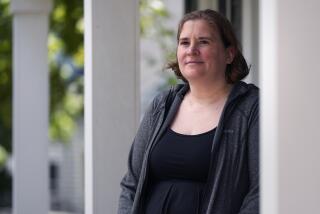System Overlooks Hungry Children in Affluent O.C.
- Share via
ANAHEIM — For every famished student Barry Sackin sees attacking the salad bar or tearing into a spicy burrito in cafeterias throughout the Anaheim Union High School District, he believes there are other students going hungry.
Sackin, the district’s food services director, doesn’t yet have specific numbers to back up his hunch, but he and other food service employees in county schools said hundreds--perhaps thousands--of children are being rejected from the chow line because their parents make too much money to qualify for free lunches but not enough to hand out a couple of dollars for lunch every day.
“I know for a fact that we have kids whose families’ incomes are above this (financial requirement) figure but because of the high cost of living are going hungry,” Sackin said.
From school nurses who sneak free meals to hungry youngsters to office workers who review applicants for the free lunches, school officials are reporting a growing number of families who earn more money than the federally established income level for free school food but not enough to buy lunch for their children.
While there are virtually no statistics tabulating how many youngsters struggle with hunger in county schools, educators and health experts believe the number is growing.
“We really don’t know (how many children don’t qualify),” said Sandy Landry, health and wellness administrator for the county Department of Education. “It’s a guesstimate. There are a number of them out there. If it’s 5% or 25%, I don’t know. What we do know is there are enough to cause us concern in getting them care and providing them with food.”
According to the Orange County Health Department, 16% of the county’s residents--about 380,000 people--don’t get enough to eat every day. “A large number (of them) are children,” said Felicia Nault, county nutritionist.
Families with incomes below the federal poverty line, including recipients of food stamps or Aid to Families with Dependent Children, automatically qualify for free lunches. But many students, food service officials say, are falling through the cafeteria cracks as their parents struggle to pay other bills incurred by the high cost of living in Orange County.
For example, a single mother with one child and an annual income greater than $10,946 cannot receive free school meal tickets. For a single parent with two children, the annual income threshold is $13,728, and for a family of four it is $16,510.
There is a slightly higher cutoff point for reduced-price lunches, but in many cases, families cannot even afford the cut rate. For a family of five earning annual wages beyond $27,454, school lunches can only be had for full price.
Those income levels are the same for “people living in the poorest parts of the south and the richest cities in California,” said Al Tweltridge, assistant director of child nutrition and food distribution at the state Department of Education.
With astronomical rents and other high expenses, he said, families in the state’s “richest” cities--many in Orange County among them--often find that a free lunch or one that is reduced to only 40 cents can make the difference between eating and going hungry. About 26% of the children in the Anaheim district qualify for free and discounted lunches, compared to about 8% in Irvine.
“I think Orange County’s going to have to wake up to the fact that we do have hungry kids,” said Cynthia Grennan, superintendent of the Anaheim Union High School District.
On average, high school lunches cost $1.50 for high school students and $1.45 for junior high students.
Students who are unable to afford those prices and skip lunch--students already with an empty stomach in many cases because their parents are hard-pressed to feed them breakfast--are not likely to do as well in school as those who are eating proper meals loaded with nutrients, according to nutrition experts.
“Think of it as an eight-hour fast,” said Dr. Gail Frank, a spokeswoman for the American Dietetics Assn. and a member of the school health committee at the Orange County chapter of the American Academy of Pediatrics. “These kids start learning in a handicapped fashion. Their level of alertness, their retention ability, is diminished.
“That (lunch) food is to provide one-third of the recommended daily allowances for the nutrients they need in a day,” she added. “The school lunch program was never set up so a child was kept from having something to eat because they couldn’t afford it. It concerns me if kids are falling through the cracks because of socioeconomic factors. That’s problematic.”
Betty Hoekstra, a health clerk at Brookhurst High School, cited one recent case where youngsters were denied a meal because of those socioeconomic factors. A family of four earning $2,500 a month recently came to her office seeking free school lunches for two children, but Hoekstra said she was forced to turn them away.
“I told them they’re way off the paper. They don’t even fit into the scale,” she said. “They told me, ‘But we have to pay this much for bills, this for rent,’ and I had to say, ‘I’m sorry, I can’t even take that into the picture.’ ”
Each school in Anaheim’s junior and senior high school district turns away a few dozen children a year for the program, which Sackin says adds up to at least a couple of hundred students who are going hungry. School officials contend that there are many more unreported cases.
“Those are only the kids you hear about,” said Carlota Troyer, a health clerk at Magnolia High School, referring to those who request and are denied aid. “I’m sure there’s more out there.”
Recently, Sackin addressed the problem at the monthly meeting of the Orange County Hunger Coalition, where he cultivated support for legislative lobbying to change the rules.
He told about a dozen members of the countywide organization, which includes representatives from social service agencies, churches and other nonprofit groups that aid the hungry, of his vision for a system where income levels take into account the cost of living for various regions.
Dolores Barrett, chairwoman of the Orange County Hunger Coalition, said the group formally gave its support to the idea, and members hope to begin working with Sackin to lobby local congressional representatives. Sackin has written to U.S. Sen. John Seymour (R-Calif.) in hope of enlisting his help in changing the rules.
“We think it’s really crucial that there’s a better measure for poverty than a federal guide, especially in Orange County, where it’s so expensive, particularly in costs of housing,” Barrett said. “Orange County has special needs. Sometimes it’s more difficult in a wealthy county (to see the need for such changes) because the poor go unnoticed.”
Currently, only Alaska and Hawaii use regional income levels to determine which youngsters eat free. Tweltridge said that only new legislation can change federal regulations that currently disallow cost-of-living adjustments.
Officials of the California School Food Service Assn., which has long discussed the issue, said they will be paying close attention to Sackin’s efforts to rally lobbying support.
“We need to put it on our priority list,” said Rosalie Mayberry, past president of the CSFSA’s Orange County chapter and director of food services for the Irvine Unified School District. “We do have a lot of students who are falling through the cracks. . . . It’s going to be tough for a lot of these families next year, and it’s going to be tough for us.”
An even greater problem, Mayberry said, is what to do with children who are going hungry while the painfully slow legislative process goes on.
“What do you do when you have a child who comes to you and says they’re hungry?” Mayberry said. “You feed them is what you do, and you absorb that cost, somehow.”
More to Read
Sign up for Essential California
The most important California stories and recommendations in your inbox every morning.
You may occasionally receive promotional content from the Los Angeles Times.











